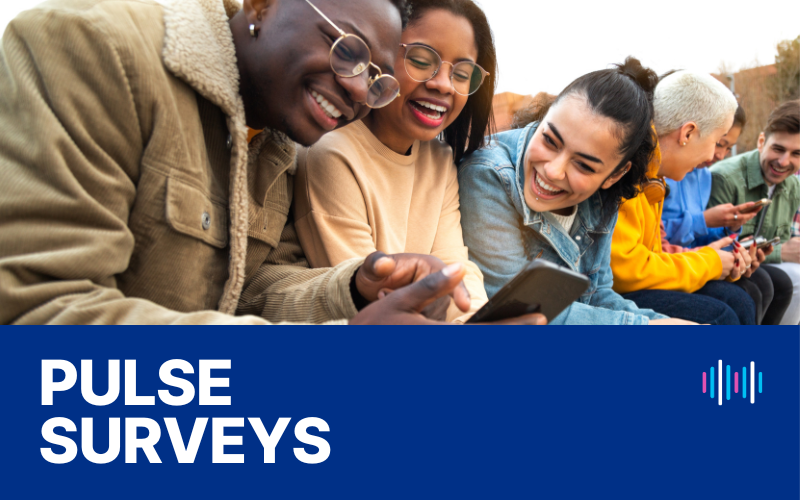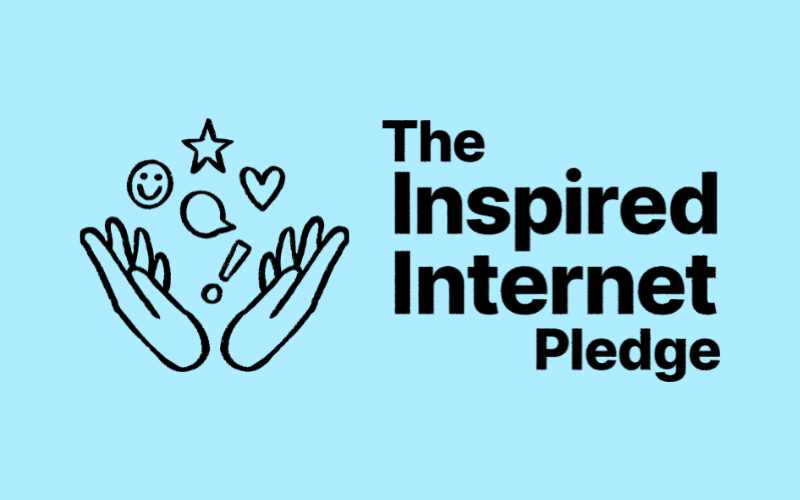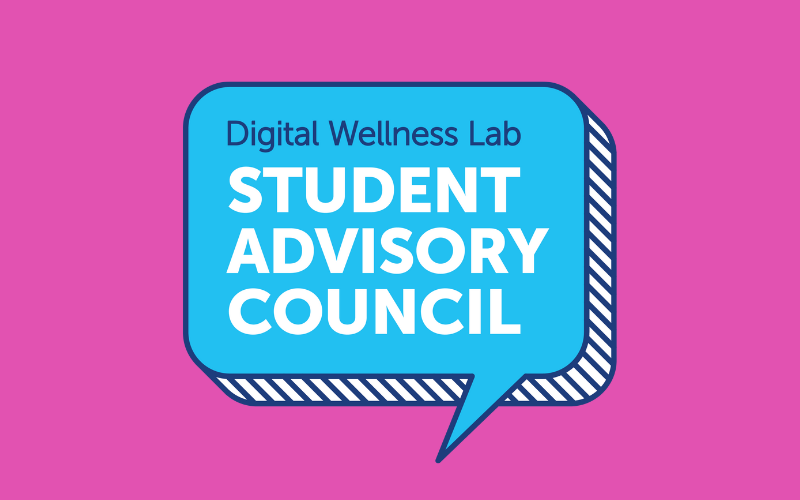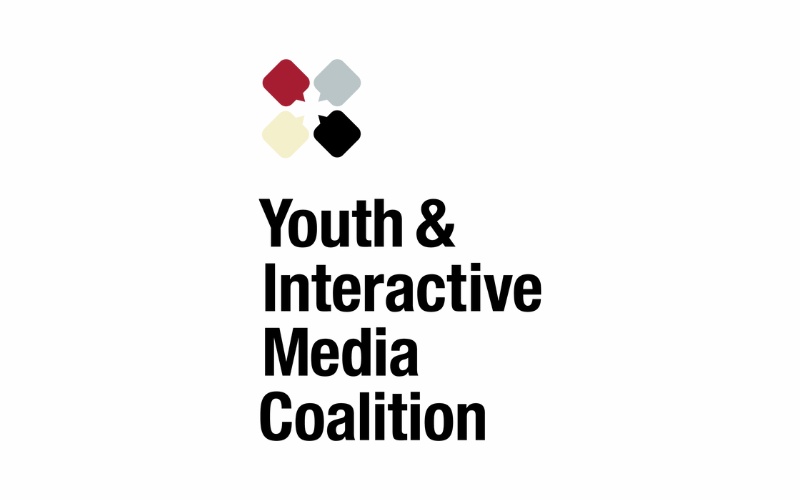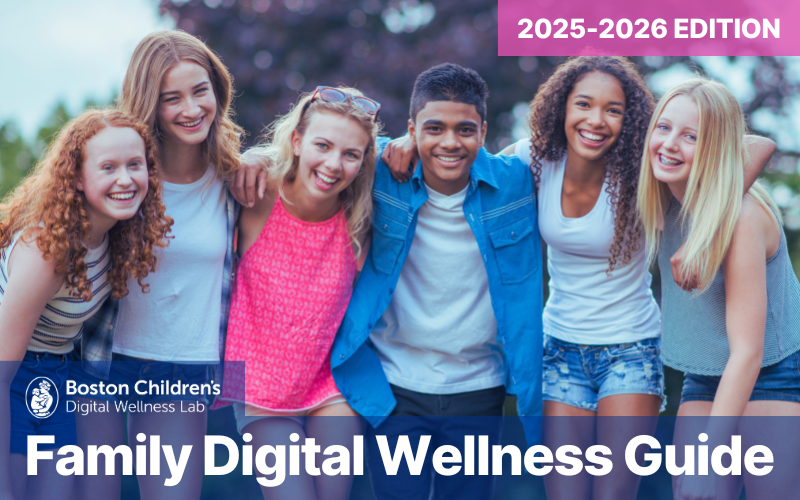Family Digital Wellness Guide
References
Birth-Preschool
Cognitive Development: Two-Year-Old. (2009). American Academy of Pediatrics. https://www.healthychildren.org/English/ages-stages/toddler/Pages/Cognitive-Development-Two-Year-Old.aspx
Cognitive Development in Preschool Children. (2009). American Academy of Pediatrics. https://www.healthychildren.org/English/ages-stages/preschool/Pages/Cognitive-Development-In-Preschool-Children.aspx
Council On Communications and Media, Hill, D., Ameenuddin, N., Reid Chassiakos, Y., Cross, C., Hutchinson, J., Levine, A., Boyd, R., Mendelson, R., Moreno, M., & Swanson, W. S. (2016). Media and Young Minds. Pediatrics, 138(5), e20162591. https://doi.org/10.1542/peds.2016-2591
Coyne, S. M., Shawcroft, J., Gale, M., Gentile, D. A., Etherington, J. T., Holmgren, H., & Stockdale, L. (2021). Tantrums, toddlers and technology: Temperament, media emotion regulation, and problematic media use in early childhood. Computers in Human Behavior, 120, 106762. https://doi.org/10.1016/j.chb.2021.106762
Denham, S. A., Renwick, S. M., & Holt, R. W. (1991). Working and Playing Together: Prediction of Preschool Social-Emotional Competence from Mother-Child Interaction. Child Development, 62(2), 242-249. https://doi.org/10.1111/j.1467-8624.1991.tb01528.x
Developmental Milestones: 4 to 5 Year Olds. (2023). American Academy of Pediatrics. https://www.healthychildren.org/English/ages-stages/preschool/Pages/Developmental-Milestones-4-to-5-Year-Olds.aspx
Domoff, S. E., Borgen, A. L., & Radesky, J. S. (2020). Interactional theory of childhood problematic media use. Human Behavior and Emerging Technologies, 2(4), 343-353. https://doi.org/10.1002/hbe2.217
Emotional Development: 1 Year Olds. (2009). American Academy of Pediatrics. https://www.healthychildren.org/English/ages-stages/toddler/Pages/Emotional-Development-1-Year-Olds.aspx
Emotional Development in Preschoolers. (2009). American Academy of Pediatrics. https://www.healthychildren.org/English/ages-stages/preschool/Pages/Emotional-Development-in-Preschoolers.aspx
Goncalves, W. S. F., Byrne, R., Viana, M. T., & Trost, S. G. (2019). Parental influences on screen time and weight status among preschool children from Brazil: a cross-sectional study. International Journal of Behavioral Nutrition and Physical Activity, 16(1), 27. https://doi.org/10.1186/s12966-019-0788-3
Growing Independence: Tips for Parents of Young Children. (2009). American Academy of Pediatrics. https://www.healthychildren.org/English/ages-stages/preschool/Pages/Growing-Independence-Tips-for-Parents-of-Young-Children.aspx
Hale, L., Kirschen, G. W., LeBourgeois, M. K., Gradisar, M., Garrison, M. M., Montgomery-Downs, H., Kirschen, H., McHale, S. M., Chang, A.-M., & Buxton, O. M. (2018). Youth Screen Media Habits and Sleep: Sleep-Friendly Screen Behavior Recommendations for Clinicians, Educators, and Parents. Child and Adolescent Psychiatric Clinics of North America, 27(2), 229-245. https://doi.org/10.1016/j.chc.2017.11.014
Harriger, J. A., Calogero, R. M., Witherington, D. C., & Smith, J. E. (2010). Body Size Stereotyping and Internalization of the Thin Ideal in Preschool Girls. Sex Roles, 63(9), 609-620. https://doi.org/10.1007/s11199-010-9868-1
How to Set Parental Controls on All Your Devices. (2021). Panda Security. https://www.pandasecurity.com/en/mediacenter/parental-control/
Kelly, D. J., Quinn, P. C., Slater, A. M., Lee, K., Gibson, A., Smith, M., Ge, L., & Pascalis, O. (2005). Three-month-olds, but not newborns, prefer own-race faces. Developmental Science, 8(6), F31-F36. https://doi.org/10.1111/j.1467-7687.2005.0434a.x
Language Development: 8 to 12 Months. (2009). American Academy of Pediatrics. https://www.healthychildren.org/English/ages-stages/baby/Pages/Language-Development-8-to-12-Months.aspx
Madigan, S., Browne, D., Racine, N., Mori, C., & Tough, S. (2019). Association Between Screen Time and Children’s Performance on a Developmental Screening Test. JAMA Pediatrics, 173(3), 244-250. https://doi.org/10.1001/jamapediatrics.2018.5056
Mayo Clinic Staff. (2022). Temper tantrums in toddlers: How to keep the peace. Mayo Clinic. https://www.mayoclinic.org/healthy-lifestyle/infant-and-toddler-health/in-depth/tantrum/art-20047845
McDaniel, B. T., & Radesky, J. S. (2018). Technoference: Parent Distraction With Technology and Associations With Child Behavior Problems. Child Development, 89(1), 100-109. https://doi.org/10.1111/cdev.12822
Meyer, M., Zosh, J. M., McLaren, C., Robb, M., McCaffery, H., Golinkoff, R. M., Hirsh-Pasek, K., & Radesky, J. (2021). How educational are “educational” apps for young children? App store content analysis using the Four Pillars of Learning framework. Journal of Children and Media, 15(4), 526-548. https://doi.org/10.1080/17482798.2021.1882516
Myers, L. J., LeWitt, R. B., Gallo, R. E., & Maselli, N. M. (2017). Baby FaceTime: can toddlers learn from online video chat? Developmental Science, 20(4), e12430. https://doi.org/10.1111/desc.12430
Padilla-Walker, L. M., Coyne, S. M., Booth, M. A., Domoff, S. E., Summers, K., Schvaneveldt, E., & Stockdale, L. (2020). Parent–child joint media engagement in infancy. Infancy, 25(5), 552-570. https://doi.org/10.1111/infa.12355
Piper, D., Malik, S., Badger, A. N., Washington, C., Valle, B., Strouse, G. A., Myers, L. J., McClure, E., Troseth, G. L., Zosh, J. M., & Barr, R. (2023). Sharing culture in a tech world: Grandparent–grandchild cultural exchanges over video chat. Translational Issues in Psychological Science, 9(3), 289-304. https://doi.org/10.1037/tps0000358
Quintana, S. M. (1998). Children’s developmental understanding of ethnicity and race. Applied and Preventive Psychology, 7(1), 27-45. https://doi.org/10.1016/S0962-1849(98)80020-6
Radesky, J., Hiniker, A., McLaren, C., Akgun, E., Schaller, A., Weeks, H. M., Campbell, S., & Gearhardt, A. N. (2022). Prevalence and Characteristics of Manipulative Design in Mobile Applications Used by Children. JAMA Network Open, 5(6), e2217641-e2217641. https://doi.org/10.1001/jamanetworkopen.2022.17641
Radesky, J. S., Kaciroti, N., Weeks, H. M., Schaller, A., & Miller, A. L. (2023). Longitudinal Associations Between Use of Mobile Devices for Calming and Emotional Reactivity and Executive Functioning in Children Aged 3 to 5 Years. JAMA Pediatrics, 177(1), 62-70. https://doi.org/10.1001/jamapediatrics.2022.4793
Radesky, J. S., Weeks, H. M., Ball, R., Schaller, A., Yeo, S., Durnez, J., Tamayo-Rios, M., Epstein, M., Kirkorian, H., Coyne, S., & Barr, R. (2020). Young Children’s Use of Smartphones and Tablets. Pediatrics, 146(1), e20193518. https://doi.org/10.1542/peds.2019-3518
Reading Rockets. (n.d). How to Read an E-book with Your Child. WETA. Retrieved November 28 from https://www.readingrockets.org/topics/ed-tech-and-digital-media/articles/how-read-e-book-your-child
Rideout, V., & Robb, M. B. (2020). The Common Sense census: Media use by kids age zero to eight, 2020. San Francisco, CA: Common Sense Media. https://www.commonsensemedia.org/sites/default/files/research/report/2020_zero_to_eight_census_final_web.pdf
Robinson, C. A., Domoff, S. E., Kasper, N., Peterson, K. E., & Miller, A. L. (2022). The healthfulness of children’s meals when multiple media and devices are present. Appetite, 169, 105800. https://doi.org/10.1016/j.appet.2021.105800
Rueda, M. R., & Conejero, A. (2020). Chapter 23 – Developing attention and self-regulation in infancy and childhood. In J. Rubenstein, P. Rakic, B. Chen, & K. Y. Kwan (Eds.), Neural Circuit and Cognitive Development (Second Edition) (pp. 505-522). Academic Press. https://doi.org/10.1016/B978-0-12-814411-4.00023-8
Shin, E., Choi, K., Resor, J., & Smith, C. L. (2021). Why do parents use screen media with toddlers? The role of child temperament and parenting stress in early screen use. Infant Behavior and Development, 64, 101595. https://doi.org/10.1016/j.infbeh.2021.101595
Social Development in Preschoolers. (2021). American Academy of Pediatrics. https://www.healthychildren.org/English/ages-stages/preschool/Pages/Social-Development-in-Preschoolers.aspx
Strouse, G. A., McClure, E., Myers, L. J., Zosh, J. M., Troseth, G. L., Blanchfield, O., Roche, E., Malik, S., & Barr, R. (2021). Zooming through development: Using video chat to support family connections. Human Behavior and Emerging Technologies, 3(4), 552-571. https://doi.org/10.1002/hbe2.268
Troseth, G. L., Strouse, G. A., Verdine, B. N., & Saylor, M. M. (2018). Let’s Chat: On-Screen Social Responsiveness Is Not Sufficient to Support Toddlers’ Word Learning From Video. Frontiers in Psychology, 9. https://www.frontiersin.org/articles/10.3389/fpsyg.2018.02195
Vik, F. N., Grasaas, E., Polspoel, M. E. M., Røed, M., Hillesund, E. R., & Øverby, N. C. (2021). Parental phone use during mealtimes with toddlers and the associations with feeding practices and shared family meals: a cross-sectional study. BMC Public Health, 21(1), 756. https://doi.org/10.1186/s12889-021-10757-1
Grade School-Tween
Adolescent development. (n.d). Mount Sinai. Retrieved November 28 from https://www.mountsinai.org/health-library/special-topic/adolescent-development
Ages and Stages of Development. (2023). https://www.cde.ca.gov/sp/cd/re/caqdevelopment.asp
Anderson, C. G., Dalsen, J., Kumar, V., Berland, M., & Steinkuehler, C. (2018). Failing up: How failure in a game environment promotes learning through discourse. Thinking Skills and Creativity, 30, 135-144. https://doi.org/10.1016/j.tsc.2018.03.002
Anderson, M. (2016, January 7). How parents monitor their teen’s digital behavior. Pew Research Center. https://www.pewresearch.org/internet/2016/01/07/how-parents-monitor-their-teens-digital-behavior/
Auxier, B., Anderson, M., Perrin, A., & Turner, E. (2020, July 28). Children’s engagement with digital devices, screen time. Pew Research Center. https://www.pewresearch.org/internet/2020/07/28/childrens-engagement-with-digital-devices-screen-time/
Auxier, B., Anderson, M., Perrin, A., & Turner, E. (2020, July 28). Parenting approaches and concerns related to digital devices. Pew Research Center. https://www.pewresearch.org/internet/2020/07/28/parenting-approaches-and-concerns-related-to-digital-devices/
Bickham, D., Hunt, E., Kavanaugh, J. R., & Rich, M. (2021, December 17). Children’s First Cell Phones: Parents’ Perspectives on Risks and Benefits. Boston, MA: Boston Children’s Digital Wellness Lab. https://digitalwellnesslab.org/research/pulse-surveys/childrens-first-cell-phones-parents-perspectives-on-risks-and-benefits/
Brockmyer, J. F. (2022). Desensitization and Violent Video Games: Mechanisms and Evidence. Child and Adolescent Psychiatric Clinics of North America, 31(1), 121-132. https://doi.org/10.1016/j.chc.2021.06.005
Building Blocks for Healthy Self Esteem in Kids. (2022). https://www.healthychildren.org/English/ages-stages/gradeschool/Pages/Helping-Your-Child-Develop-A-Healthy-Sense-of-Self-Esteem.aspx
Bushweller, K. (2022, May 17). What the Massive Shift to 1-to-1 Computer Means for Schools, in Charts. Education Week. https://www.edweek.org/technology/what-the-massive-shift-to-1-to-1-computing-means-for-schools-in-charts/2022/05
Canadian Paediatric Society Digital Health Task Force Ottawa Ontario. (2019). Digital media: Promoting healthy screen use in school-aged children and adolescents. Paediatrics & Child Health, 24(6), 402-408. https://doi.org/10.1093/pch/pxz095
Carter, M., Moore, K., Mavoa, J., Horst, H., & gaspard, l. (2020). Situating the Appeal of Fortnite Within Children’s Changing Play Cultures. Games and Culture, 15(4), 453-471. https://doi.org/10.1177/1555412020913771
Charmaraman, L., Lynch, A. D., Richer, A. M., & Grossman, J. M. (2022). Associations of early social media initiation on digital behaviors and the moderating role of limiting use. Computers in Human Behavior, 127, 107053. https://doi.org/10.1016/j.chb.2021.107053
Coates, A. E., Hardman, C. A., Halford, J. C. G., Christiansen, P., & Boyland, E. J. (2019). Food and Beverage Cues Featured in YouTube Videos of Social Media Influencers Popular With Children: An Exploratory Study. Frontiers in Psychology, 10. https://doi.org/10.3389/fpsyg.2019.02142
Cowan, K., Potter, J., Olusoga, Y., Banniester, C., Bishop, J. C., Cannon, M., & Signorelli, V. (2021). Children’s Digital Play during the COVID-19 Pandemic: insights from the Play Observatory. Journal of E-Learning and Knowledge Society, 17(3), 8-17. https://doi.org/10.20368/1971-8829/1135590
Coyne, S. M., Padilla-Walker, L. M., Stockdale, L., & Day, R. D. (2011). Game On… Girls: Associations Between Co-playing Video Games and Adolescent Behavioral and Family Outcomes. Journal of Adolescent Health, 49(2), 160-165. https://doi.org/10.1016/j.jadohealth.2010.11.249
Davis, A. C., Wright, C., Curtis, M., Hellard, M. E., Lim, M. S. C., & Temple-Smith, M. J. (2021). ‘Not my child’: parenting, pornography, and views on education. Journal of Family Studies, 27(4), 573-588. https://doi.org/10.1080/13229400.2019.1657929
De Coen, J., Verbeken, S., & Goossens, L. (2021). Media influence components as predictors of children’s body image and eating problems: A longitudinal study of boys and girls during middle childhood. Body Image, 37, 204-213. https://doi.org/10.1016/j.bodyim.2021.03.001
De Jesus, I. Q., & Hubbard, J. (2021). Media Literacy for Elementary Education Students: Inquiry into Fake News. The Social Studies, 112(3), 136-145. https://doi.org/10.1080/00377996.2020.1841717
de Jong, E., Visscher, T. L. S., HiraSing, R. A., Heymans, M. W., Seidell, J. C., & Renders, C. M. (2013). Association between TV viewing, computer use and overweight, determinants and competing activities of screen time in 4- to 13-year-old children. International Journal of Obesity, 37(1), 47-53. https://doi.org/10.1038/ijo.2011.244
De Veirman, M., Hudders, L., & Nelson, M. R. (2019). What Is Influencer Marketing and How Does It Target Children? A Review and Direction for Future Research. Frontiers in Psychology, 10. https://doi.org/10.3389/fpsyg.2019.02685
Evangelio, C., Rodríguez-González, P., Fernández-Río, J., & Gonzalez-Villora, S. (2022). Cyberbullying in elementary and middle school students: A systematic review. Computers & Education, 176, 104356. https://doi.org/10.1016/j.compedu.2021.104356
Eyuboglu, M., Eyuboglu, D., Pala, S. C., Oktar, D., Demirtas, Z., Arslantas, D., & Unsal, A. (2021). Traditional school bullying and cyberbullying: Prevalence, the effect on mental health problems and self-harm behavior. Psychiatry Research, 297, 113730. https://doi.org/10.1016/j.psychres.2021.113730
Family Media Plan. (n.d). American Academy of Pediatrics. Retrieved November 28 from https://www.healthychildren.org/English/fmp/Pages/MediaPlan.aspx
Fardouly, J., Magson, N. R., Rapee, R. M., Johnco, C. J., & Oar, E. L. (2020). The use of social media by Australian preadolescents and its links with mental health. Journal of Clinical Psychology, 76(7), 1304-1326. https://doi.org/10.1002/jclp.22936
Flood, M. (2009). The harms of pornography exposure among children and young people. Child Abuse Review, 18(6), 384-400. https://doi.org/10.1002/car.1092
Fulantelli, G., Taibi, D., Scifo, L., Schwarze, V., & Eimler, S. C. (2022). Cyberbullying and Cyberhate as Two Interlinked Instances of Cyber-Aggression in Adolescence: A Systematic Review. Frontiers in Psychology, 13. https://doi.org/10.3389/fpsyg.2022.909299
Hobbs, R. (2017). Chapter 13 – Measuring the Digital and Media Literacy Competencies of Children and Teens. In F. C. Blumberg & P. J. Brooks (Eds.), Cognitive Development in Digital Contexts (pp. 253-274). Academic Press. https://doi.org/10.1016/B978-0-12-809481-5.00013-4“>https://doi.org/10.1016/B978-0-12-809481-5.00013-4”>https://doi.org/10.1016/B978-0-12-809481-5.00013-4
How to Talk About Bullying. (2021). stopbullying.gov. https://www.stopbullying.gov/resources/how-to-talk-about-bullying
Kim, A. S., & Davis, K. (2017). Tweens’ perspectives on their parents’ media-related attitudes and rules: an exploratory study in the US. Journal of Children and Media, 11(3), 358-366. https://doi.org/10.1080/17482798.2017.1308399
LaFontana, K. M., & Cillessen, A. H. N. (2010). Developmental Changes in the Priority of Perceived Status in Childhood and Adolescence. Social Development, 19(1), 130-147. https://doi.org/10.1111/j.1467-9507.2008.00522.x
Mavoa, J., Carter, M., & Gibbs, M. (2017). Children and Minecraft: A survey of children’s digital play. New Media & Society, 20(9), 3283-3303. https://doi.org/10.1177/1461444817745320
McDaniel, B. T., Gullo, N., Kaiser, Z., Reining, L., Chang, I. J., & Drouin, M. (2023). School-Issued Devices for Home Use in Kindergarten through 5th Grade and Parent Perceptions of Child Learning, Behavior, and Conflict. Human Behavior and Emerging Technologies, 3240832. https://doi.org/10.1155/2023/3240832
Meeus, A., Coenen, L., Eggermont, S., & Beullens, K. (2021). Family technoference: Exploring parent mobile device distraction from children’s perspectives. Mobile Media & Communication, 9(3), 584-604. https://doi.org/10.1177/2050157921991602
Meeus, A., Eggermont, S., & Beullens, K. (2019). Constantly Connected: The Role of Parental Mediation Styles and Self-Regulation in Pre- and Early Adolescents’ Problematic Mobile Device Use. Human Communication Research, 45(2), 119-147. https://doi.org/10.1093/hcr/hqy015
Moreno, M. A., Kerr, B. R., Jenkins, M., Lam, E., & Malik, F. S. (2019). Perspectives on Smartphone Ownership and Use by Early Adolescents. Journal of Adolescent Health, 64(4), 437-442. https://doi.org/10.1016/j.jadohealth.2018.08.017
Naderer, B., Peter, C., & Karsay, K. (2022). This picture does not portray reality: developing and testing a disclaimer for digitally enhanced pictures on social media appropriate for Austrian tweens and teens. Journal of Children and Media, 16(2), 149-167. https://doi.org/10.1080/17482798.2021.1938619
Neumann, M. M., Park, E., Soong, H., Nichols, S., & Selim, N. (2022). Exploring the social media networks of primary school children. Education 3-13, 1-15. https://doi.org/10.1080/03004279.2022.2144404
Ouvrein, G., & Verswijvel, K. (2019). Sharenting: Parental adoration or public humiliation? A focus group study on adolescents’ experiences with sharenting against the background of their own impression management. Children and Youth Services Review, 99, 319-327. https://doi.org/10.1016/j.childyouth.2019.02.011
Pearce, K. E., Yip, J. C., Lee, J. H., Martinez, J. J., Windleharth, T. W., Bhattacharya, A., & Li, Q. (2021). Families Playing Animal Crossing Together: Coping With Video Games During the COVID-19 Pandemic. Games and Culture, 17(5), 773-794. https://doi.org/10.1177/15554120211056125
Physical Development: What’s Normal? What’s Not? (2015). American Academy of Pediatrics. https://www.healthychildren.org/English/ages-stages/gradeschool/puberty/Pages/Physical-Development-Whats-Normal-Whats-Not.aspx
Prevent Cyberbullying. (2021). https://www.stopbullying.gov/cyberbullying/prevention
Pursey, K. M., Burrows, T. L., Barker, D., Hart, M., & Paxton, S. J. (2021). Disordered eating, body image concerns, and weight control behaviors in primary school aged children: A systematic review and meta-analysis of universal–selective prevention interventions. International Journal of Eating Disorders, 54(10), 1730-1765. https://doi.org/10.1002/eat.23571
Radesky, J., Miller, A. L., Rosenblum, K. L., Appugliese, D., Kaciroti, N., & Lumeng, J. C. (2015). Maternal Mobile Device Use During a Structured Parent–Child Interaction Task. Academic Pediatrics, 15(2), 238-244. https://doi.org/10.1016/j.acap.2014.10.001
Radesky, J., Weeks, H. M., Schaller, A., Robb, M. B., Mann, S., & Lenhart, A. (2023). Constant Companion: A Week in the Life of a Young Person’s Smartphone Use. San Francisco, CA: Common Sense Media. https://www.commonsensemedia.org/sites/default/files/research/report/2023-cs-smartphone-research-report_final-for-web.pdf
Ramdass, D., & Zimmerman, B. J. (2011). Developing Self-Regulation Skills: The Important Role of Homework. Journal of Advanced Academics, 22(2), 194-218. https://doi.org/10.1177/1932202X1102200202
Rasmussen, E. E., Riggs, R. E., & Sauermilch, W. S. (2022). Kidfluencer exposure, materialism, and U.S. tweens’ purchase of sponsored products. Journal of Children and Media, 16(1), 68-77. https://doi.org/10.1080/17482798.2021.1910053
Report Cyberbullying. (2018). stopbullying.gov. https://www.stopbullying.gov/cyberbullying/how-to-report
Rideout, V., Peebles, A., Mann, S., & Robb, M. B. (2022). Common Sense census: Media use by tweens and teens, 2021. San Francisco, CA: Common Sense Media. https://www.commonsensemedia.org/sites/default/files/research/report/8-18-census-integrated-report-final-web_0.pdf
Rideout, V., & Robb, M. B. (2020). The Common Sense census: Media use by kids age zero to eight, 2020. San Francisco, CA: Common Sense Media. https://www.commonsensemedia.org/sites/default/files/research/report/2020_zero_to_eight_census_final_web.pdf
Robb, M. B., & Mann, S. (2023). Teens and Pornography. San Francisco, CA: Common Sense Media. https://www.commonsensemedia.org/sites/default/files/research/report/2022-teens-and-pornography-final-web.pdf
Robinson, T. N., Banda, J. A., Hale, L., Lu, A. S., Fleming-Milici, F., Calvert, S. L., & Wartella, E. (2017). Screen Media Exposure and Obesity in Children and Adolescents. Pediatrics, 140(Supplement_2), S97-S101. https://doi.org/10.1542/peds.2016-1758K
Rousseau, A., & Eggermont, S. (2018). Tween Television and Peers: Reinforcing Social Agents in Early Adolescents’ Body Surveillance and Self-Objectification. Journal of Research on Adolescence, 28(4), 807-823. https://doi.org/10.1111/jora.12367
School-age children development. (n.d). Mount Sinai. Retrieved November 28 from https://www.mountsinai.org/health-library/special-topic/school-age-children-development
Semrud-Clikeman, M. (2015). Research in Brain Function and Learning: Applications of Psychological Science to Teaching and Learning modules. American Psychological Association. https://www.apa.org/education-career/k12/brain-function
Shoshani, A., & Krauskopf, M. (2021). The Fortnite social paradox: The effects of violent-cooperative multi-player video games on children’s basic psychological needs and prosocial behavior. Computers in Human Behavior, 116, 106641. https://doi.org/10.1016/j.chb.2020.106641
The Digital Wellness Lab. (2022, August 22). Parent’s Guide to Going Back to School with Technology. https://digitalwellnesslab.org/guides/parents-guide-to-going-back-to-school-with-technology/
The Digital Wellness Lab. (2022, July 9). Parent’s Guide to a Child’s First Cell Phone. https://digitalwellnesslab.org/guides/parents-guide-to-a-childs-first-cell-phone/
Timeo, S., Riva, P., & Paladino, M. P. (2020). Being liked or not being liked: A study on social-media exclusion in a preadolescent population. Journal of Adolescence, 80, 173-181. https://doi.org/10.1016/j.adolescence.2020.02.010
Tolbert, A. N., & Drogos, K. L. (2019). Tweens’ Wishful Identification and Parasocial Relationships With YouTubers. Frontiers in Psychology, 10. https://doi.org/10.3389/fpsyg.2019.02781
Uncapher, M. R., Lin, L., Rosen, L. D., Kirkorian, H. L., Baron, N. S., Bailey, K., Cantor, J., Strayer, D. L., Parsons, T. D., & Wagner, A. D. (2017). Media Multitasking and Cognitive, Psychological, Neural, and Learning Differences. Pediatrics, 140(Supplement_2), S62-S66. https://doi.org/10.1542/peds.2016-1758D
Uribe, R., & Fuentes-García, A. (2017). Comparing children’s explicit and implicit understanding of advertising and placement on TV. International Journal of Advertising, 36(6), 928-944. https://doi.org/10.1080/02650487.2017.1384197
Vincent, J. (2015). Mobile Opportunities: Exploring positive mobile media opportunities for European children. POLIS & The London School of Economics and Political Science. http://eprints.lse.ac.uk/61015/
Wisniewski, P., Jia, H., Xu, H., Rosson, M. B., & Carroll, J. M. (2015). “Preventative” vs. “Reactive”: How Parental Mediation Influences Teens’ Social Media Privacy Behaviors Proceedings of the 18th ACM Conference on Computer Supported Cooperative Work & Social Computing, Vancouver, BC, Canada. https://doi.org/10.1145/2675133.2675293
Yang, X., Jiang, P., & Zhu, L. (2023). Parental Problematic Smartphone Use and Children’s Executive Function: The Mediating Role of Technoference and the Moderating Role of Children’s Age. Early Childhood Research Quarterly, 63, 219-227. https://doi.org/10.1016/j.ecresq.2022.12.017
Zhang, R.-Y., Chopin, A., Shibata, K., Lu, Z.-L., Jaeggi, S. M., Buschkuehl, M., Green, C. S., & Bavelier, D. (2021). Action video game play facilitates “learning to learn”. Communications Biology, 4(1), 1154. https://doi.org/10.1038/s42003-021-02652-7
Teens & Young Adults
Adolescent development. (n.d). Mount Sinai. Retrieved November 28 from https://www.mountsinai.org/health-library/special-topic/adolescent-development
Anderson, C. G., Dalsen, J., Kumar, V., Berland, M., & Steinkuehler, C. (2018). Failing up: How failure in a game environment promotes learning through discourse. Thinking Skills and Creativity, 30, 135-144. https://doi.org/10.1016/j.tsc.2018.03.002
Auxier, B., & Anderson, M. (2021, April 7). Social Media Use in 2021. Pew Research Center. https://www.pewresearch.org/internet/2021/04/07/social-media-use-in-2021/
Azizli, N., Atkinson, B. E., Baughman, H. M., & Giammarco, E. A. (2015). Relationships between general self-efficacy, planning for the future, and life satisfaction. Personality and Individual Differences, 82, 58-60. https://doi.org/10.1016/j.paid.2015.03.006
Beyens, I., Keijsers, L., & Coyne, S. M. (2022). Social media, parenting, and well-being. Current Opinion in Psychology, 47, 101350. https://doi.org/10.1016/j.copsyc.2022.101350
Beyens, I., Pouwels, J. L., van Driel, I. I., Keijsers, L., & Valkenburg, P. M. (2020). The effect of social media on well-being differs from adolescent to adolescent. Scientific Reports, 10, 10763. https://doi.org/10.1038/s41598-020-67727-7
Bickham, D., Hunt, E., Bediou, B., & Rich, M. (2022). Adolescent Media Use: Attitudes, Effects, and Online Experiences. Boston, MA: Boston Children’s Digital Wellness Lab. https://digitalwellnesslab.org/wp-content/uploads/Pulse-Survey_Adolescent-Attitudes-Effects-and-Experiences.pdf
Burnette, C. B., Kwitowski, M. A., & Mazzeo, S. E. (2017). “I don’t need people to tell me I’m pretty on social media:” A qualitative study of social media and body image in early adolescent girls. Body Image, 23, 114-125. https://doi.org/10.1016/j.bodyim.2017.09.001
Carter, M., Moore, K., Mavoa, J., Horst, H., & gaspard, l. (2020). Situating the Appeal of Fortnite Within Children’s Changing Play Cultures. Games and Culture, 15(4), 453-471. https://doi.org/10.1177/1555412020913771
Delmonaco, D., & Haimson, O. L. (2023). “Nothing that I was specifically looking for”: LGBTQ + youth and intentional sexual health information seeking. Journal of LGBT Youth, 20(4), 818-835. https://doi.org/10.1080/19361653.2022.2077883
Distracted Driving. (n.d). National Highway Traffic Safety Administration. Retrieved November 29 from https://www.nhtsa.gov/risky-driving/distracted-driving
Elsaesser, C., Russell, B., Ohannessian, C. M., & Patton, D. (2017). Parenting in a digital age: A review of parents’ role in preventing adolescent cyberbullying. Aggression and Violent Behavior, 35, 62-72. https://doi.org/10.1016/j.avb.2017.06.004
Englander, E. K. (2019). 78.5 SEXTING IN LGBT YOUTH. Journal of the American Academy of Child & Adolescent Psychiatry, 58(10, Supplement), S112-S113. https://doi.org/10.1016/j.jaac.2019.07.580
Eyuboglu, M., Eyuboglu, D., Pala, S. C., Oktar, D., Demirtas, Z., Arslantas, D., & Unsal, A. (2021). Traditional school bullying and cyberbullying: Prevalence, the effect on mental health problems and self-harm behavior. Psychiatry Research, 297, 113730. https://doi.org/10.1016/j.psychres.2021.113730
Family Media Plan. (n.d). American Academy of Pediatrics. Retrieved November 28 from https://www.healthychildren.org/English/fmp/Pages/MediaPlan.aspx
FAQ on ‘Sexting’ and ‘Sextortion’. (2018, April 2). ConnectSafely. https://connectsafely.org/faq-on-sexting-and-sextortion/
Ginsburg, K. R. (2011). Independence, One Step at a Time. American Academy of Pediatrics. https://www.healthychildren.org/English/ages-stages/teen/Pages/Independence-One-Step-at-a-Time.aspx
Hawes, T., Zimmer-Gembeck, M. J., & Campbell, S. M. (2020). Unique associations of social media use and online appearance preoccupation with depression, anxiety, and appearance rejection sensitivity. Body Image, 33, 66-76. https://doi.org/10.1016/j.bodyim.2020.02.010
How to Talk About Bullying. (2021). stopbullying.gov. https://www.stopbullying.gov/resources/how-to-talk-about-bullying
Hisler, G., Twenge, J. M., & Krizan, Z. (2020). Associations between screen time and short sleep duration among adolescents varies by media type: evidence from a cohort study. Sleep Medicine, 66, 92-102. https://doi.org/10.1016/j.sleep.2019.08.007
John, A., Glendenning, A. C., Marchant, A., Montgomery, P., Stewart, A., Wood, S., Lloyd, K., & Hawton, K. (2018). Self-Harm, Suicidal Behaviours, and Cyberbullying in Children and Young People: Systematic Review. J Med Internet Res, 20(4), e129. https://doi.org/10.2196/jmir.9044
Jose, P. E., Ryan, N., & Pryor, J. (2012). Does Social Connectedness Promote a Greater Sense of Well-Being in Adolescence Over Time? Journal of Research on Adolescence, 22(2), 235-251. https://doi.org/10.1111/j.1532-7795.2012.00783.x
Kriegel, E. R., Lazarevic, B., Athanasian, C. E., & Milanaik, R. L. (2021). TikTok, Tide Pods and Tiger King: health implications of trends taking over pediatric populations. Current Opinion in Pediatrics, 33(1). https://doi.org/10.1097/MOP.0000000000000989
Leffer, L. (2023, October 26). Humans Absorb Bias from AI — And Keep It after They Stop Using the Algorithm. Scientific American. https://www.scientificamerican.com/article/humans-absorb-bias-from-ai-and-keep-it-after-they-stop-using-the-algorithm/
Lou, C., & Kim, H. K. (2019). Fancying the New Rich and Famous? Explicating the Roles of Influencer Content, Credibility, and Parental Mediation in Adolescents’ Parasocial Relationship, Materialism, and Purchase Intentions. Frontiers in Psychology, 10. https://doi.org/10.3389/fpsyg.2019.02567
Lui, Y., Campbell, M. A., & Whiteford, C. (2022). “Snitches Get Stitches”: Why Most Bullied Young People Don’t Disclose Incidents of Bullying and Harassment. In A. Akande (Ed.), Handbook of Racism, Xenophobia, and Populism: All Forms of Discrimination in the United States and Around the Globe (pp. 785-803). Springer International Publishing. https://doi.org/10.1007/978-3-031-13559-0_35
Madigan, S., Ly, A., Rash, C. L., Van Ouytsel, J., & Temple, J. R. (2018). Prevalence of Multiple Forms of Sexting Behavior Among Youth: A Systematic Review and Meta-analysis. JAMA Pediatrics, 172(4), 327-335. https://doi.org/10.1001/jamapediatrics.2017.5314
May, K. E., & Elder, A. D. (2018). Efficient, helpful, or distracting? A literature review of media multitasking in relation to academic performance. International Journal of Educational Technology in Higher Education, 15(1), 13. https://doi.org/10.1186/s41239-018-0096-z
Mihailidis, P., & Thevenin, B. (2013). Media Literacy as a Core Competency for Engaged Citizenship in Participatory Democracy. American Behavioral Scientist, 57(11), 1611-1622. https://doi.org/10.1177/0002764213489015
Mori, C., Temple, J. R., Browne, D., & Madigan, S. (2019). Association of Sexting With Sexual Behaviors and Mental Health Among Adolescents: A Systematic Review and Meta-analysis. JAMA Pediatrics, 173(8), 770-779. https://doi.org/10.1001/jamapediatrics.2019.1658
National Highway Traffic Safety Administration. (2022). Teen Distracted Driver Data. U.S. Department of Transportation. https://crashstats.nhtsa.dot.gov/Api/Public/ViewPublication/813453
Nixon, C. L. (2014). Current perspectives: the impact of cyberbullying on adolescent health. Adolescent health, medicine and therapeutics, 5, 143-158. https://doi.org/10.2147/AHMT.S36456
Ouvrein, G., & Verswijvel, K. (2019). Sharenting: Parental adoration or public humiliation? A focus group study on adolescents’ experiences with sharenting against the background of their own impression management. Children and Youth Services Review, 99, 319-327. https://doi.org/10.1016/j.childyouth.2019.02.011
Padilla-Walker, L. M., Stockdale, L. A., & McLean, R. D. (2020). Associations Between Parental Media Monitoring, Media Use, and Internalizing Symptoms During Adolescence. Psychology of popular media, 9(4), 481-492. https://doi.org/10.1037/ppm0000256
Prevent Cyberbullying. (2021). https://www.stopbullying.gov/cyberbullying/prevention
Radesky, J., Weeks, H. M., Schaller, A., Robb, M. B., Mann, S., & Lenhart, A. (2023). Constant Companion: A Week in the Life of a Young Person’s Smartphone Use. San Francisco, CA: Common Sense Media. https://www.commonsensemedia.org/sites/default/files/research/report/2023-cs-smartphone-research-report_final-for-web.pdf
Reed, L. A., Boyer, M. P., Meskunas, H., Tolman, R. M., & Ward, L. M. (2020). How do adolescents experience sexting in dating relationships? Motivations to sext and responses to sexting requests from dating partners. Children and Youth Services Review, 109, 104696. https://doi.org/10.1016/j.childyouth.2019.104696
Report Cyberbullying. (2018). stopbullying.gov. https://www.stopbullying.gov/cyberbullying/how-to-report
Rideout, V., Peebles, A., Mann, S., & Robb, M. B. (2022). Common Sense census: Media use by tweens and teens, 2021. San Francisco, CA: Common Sense Media. https://www.commonsensemedia.org/sites/default/files/research/report/8-18-census-integrated-report-final-web_0.pdf
Rideout, V., & Robb, M. B. (2019). The Common Sense census: Media use by tweens and teens, 2019. San Francisco, CA: Common Sense Media. https://www.commonsensemedia.org/sites/default/files/research/report/2019-census-8-to-18-key-findings-updated.pdf
Robb, M. B., & Mann, S. (2023). Teens and Pornography. San Francisco, CA: Common Sense Media. https://www.commonsensemedia.org/sites/default/files/research/report/2022-teens-and-pornography-final-web.pdf
Rodgers, R. F., Slater, A., Gordon, C. S., McLean, S. A., Jarman, H. K., & Paxton, S. J. (2020). A Biopsychosocial Model of Social Media Use and Body Image Concerns, Disordered Eating, and Muscle-Building Behaviors among Adolescent Girls and Boys. Journal of Youth and Adolescence, 49(2), 399-409. https://doi.org/10.1007/s10964-019-01190-0
Scott, H., Biello, S. M., & Woods, H. C. (2019). Identifying drivers for bedtime social media use despite sleep costs: The adolescent perspective. Sleep Health, 5(6), 539-545. https://doi.org/10.1016/j.sleh.2019.07.006
Scott, H., & Woods, H. C. (2018). Fear of missing out and sleep: Cognitive behavioural factors in adolescents’ nighttime social media use. Journal of Adolescence, 68, 61-65. https://doi.org/10.1016/j.adolescence.2018.07.009
Sexting Laws Across America. (2022). Cyberbullying Research Center. https://cyberbullying.org/sexting-laws
Sidoti, O., & Gottfied, J. (2023, November 16). About 1 in 5 U.S. teens who’ve heard of ChatGPT have used it for schoolwork. Pew Research Center. https://www.pewresearch.org/short-reads/2023/11/16/about-1-in-5-us-teens-whove-heard-of-chatgpt-have-used-it-for-schoolwork/
Simpson, R. (2018). Brain Changes. Massachusetts Institute of Technology. https://hr.mit.edu/static/worklife/youngadult/brain.html#adolescence
Simpson, R. (2018). Ten Tasks of Adolescent Development. Massachusetts Institute of Technology. https://hr.mit.edu/static/worklife/raising-teens/ten-tasks.html
Singer, N. (2023, September 1). Ban or Embrace? Colleges Wrestle With A.I.-Generated Admissions Essays. The New York Times. https://www.nytimes.com/2023/09/01/business/college-admissions-essay-ai-chatbots.html
Sleep in Middle and High School Students. (2020). Centers for Disease Control and Prevention. https://archive.cdc.gov/#/details?url=https://www.cdc.gov/healthyschools/features/students-sleep.htm
Stockdale, L. A., Coyne, S. M., & Padilla-Walker, L. M. (2018). Parent and Child Technoference and socioemotional behavioral outcomes: A nationally representative study of 10- to 20-year-Old adolescents. Computers in Human Behavior, 88, 219-226. https://doi.org/10.1016/j.chb.2018.06.034
Symons, K., Ponnet, K., Walrave, M., & Heirman, W. (2018). Sexting scripts in adolescent relationships: Is sexting becoming the norm? New Media & Society, 20(10), 3836-3857. https://doi.org/10.1177/1461444818761869
Teen News Engagement: Key Findings and Toplines. (2019). San Francisco, CA: Common Sense Media. https://www.commonsensemedia.org/sites/default/files/research/report/2019_cs-sm_summarytoplines_release.pdf
Thorn. (2020). Self-Generated Child Sexual Abuse Material: Attitudes and Experiences. https://info.thorn.org/hubfs/Research/08112020_SG-CSAM_AttitudesExperiences-Report_2019.pdf
Valkenburg, P. M., Meier, A., & Beyens, I. (2022). Social media use and its impact on adolescent mental health: An umbrella review of the evidence. Current Opinion in Psychology, 44, 58-68. https://doi.org/10.1016/j.copsyc.2021.08.017
Vogels, E. A. (2020, February 6). 10 facts about Americans and online dating in 2019. Pew Research Center. https://www.pewresearch.org/short-reads/2020/02/06/10-facts-about-americans-and-online-dating/
Vogels, E. A., Gelles-Watnick, R., & Massarat, N. (2022, August 10). Teens, Social Media and Technology 2022. Pew Research Center. https://www.pewresearch.org/internet/2022/08/10/teens-social-media-and-technology-2022/
Wang, X., Gao, L., Yang, J., Zhao, F., & Wang, P. (2020). Parental Phubbing and Adolescents’ Depressive Symptoms: Self-Esteem and Perceived Social Support as Moderators. Journal of Youth and Adolescence, 49(2), 427-437. https://doi.org/10.1007/s10964-019-01185-x
Whitty, M. T., & Buchanan, T. (2015). The online dating romance scam: The psychological impact on victims – both financial and non-financial. Criminology & Criminal Justice, 16(2), 176-194. https://doi.org/10.1177/1748895815603773
Wineburg, S., McGrew, S., Breakstone, J., & Ortega, T. (2016). Evaluating information: The cornerstone of civic online reasoning. Stanford Digital Repository. https://purl.stanford.edu/fv751yt5934
Young, R., & Tully, M. (2022). Autonomy vs. control: Associations among parental mediation, perceived parenting styles, and U. S. adolescents’ risky online experiences. Cyberpsychology: Journal of Psychosocial Research on Cyberspace, 16 (2), Article 5. https://doi.org/10.5817/CP2022-2-5

